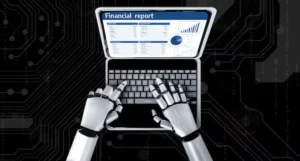The Technology Blog

AI-Driven Sales Forecasting: Revolutionising Business Strategy
In today’s hyper-competitive markets, guessing isn’t good enough. Businesses can’t just rely on gut feelings or old spreadsheets anymore to guide their strategy. The modern way to make decisions relies on data. More specifically, it uses smart data processing through AI sales forecasting.
Predictive analytics is key to this change. It helps us foresee trends, understand customer behaviours, and predict future performance accurately. Driven by AI and machine learning, sales forecasting is getting more accurate. It is also quicker, more flexible, and closely tied to the overall business strategy.
This article looks at how AI-driven forecasting is changing how businesses plan, sell, and grow. This technology can cut down human errors and spot new trends. It has the power to change the game for organisations, big or small.
What is AI Sales Forecasting?
AI sales forecasting uses artificial intelligence and machine learning to look at past data. It finds patterns and predicts future sales. AI models are different from traditional forecasting methods. Traditional methods depend a lot on manual inputs and linear projections. In contrast, AI models learn and adapt over time. They refine their predictions as new data comes in.
Key Features:
- Automated data analysis from CRMs, ERPs, and market platforms
- Real-time forecasting updates based on live data
- Dynamic modelling that accounts for seasonality, trends, and anomalies
- Natural language processing (NLP) to extract insights from qualitative inputs

Why Traditional Sales Forecasting Falls Short
Spreadsheets and historical averages have been used for forecasting, but they have key limitations:
Challenges with Traditional Methods:
- Human bias: Forecasts are often overly optimistic or conservative.
- Data silos: Incomplete data integration leads to inaccurate insights.
- Inflexibility: Static models don’t adapt to sudden market changes.
- Manual errors: Mistakes in input or formulas can significantly skew results.
AI tackles these challenges by quickly processing large amounts of data. It spots subtle patterns that humans may overlook and keeps getting better over time.
Benefits of AI-Driven Forecasting for Business Strategy
The impact of accurate forecasting extends far beyond the sales department. When predictions are smarter, the entire organisation can act more strategically.
1. Improved Accuracy and Confidence
AI uses multivariate analysis. It considers factors like customer behaviour and market conditions. This leads to more reliable predictions.
Impact: Sales managers can set clear targets. At the same time, finance teams understand future cash flow better.
2. Faster Decision-Making
Real-time dashboards and automated alerts help executives make quick, informed decisions.
Impact: Teams can pivot quickly, seizing opportunities or mitigating risks with greater agility.

3. Enhanced Inventory and Supply Chain Management
AI forecasts help match production and distribution to expected demand. This cuts down on both overstock and shortages.
Impact: Streamlined operations and cost savings across the board.
4. Sales Team Efficiency
Forecasting tools highlight underperforming areas or bottlenecks in the pipeline.
Impact: Sales reps can focus efforts where they’re most likely to convert, improving win rates.
5. Strategic Planning Alignment
With forecasting integrated into broader business strategy, leadership can allocate resources more effectively.
Impact: Marketing budgets, hiring plans, and product development all benefit from sharper foresight.
How Predictive Analytics Drives Forecasting Precision
Predictive analytics uses past data, statistical methods, and machine learning to guess future results.
Key Techniques in AI Forecasting:
- Regression analysis: Identifies the relationships between variables (e.g., advertising spend and sales).
- Time series modelling: Examines trends over time to forecast future data points.
- Classification algorithms: Predicts customer behaviours like churn or upsell probability.
- Clustering: Segments customers or products for targeted analysis.
Together, these models create a dynamic view of what’s likely to happen, when, and why.
Real-World Applications Across Industries
AI sales forecasting isn’t just for tech startups or big companies; it’s changing many industries.
Retail:
- Forecast seasonal trends and optimise inventory across locations.
- Predict which products are likely to become bestsellers.
Manufacturing:
- Align production with sales forecasts to prevent overcapacity or delays.
- Improve supply chain coordination with upstream partners.
SaaS and Subscription Services:
- Project monthly recurring revenue (MRR) with greater precision.
- Predict churn and identify renewal opportunities.
Finance and Insurance:
- Assess pipeline health and project quarterly revenue.
- Understand risk exposure based on customer buying patterns.
A global consumer electronics brand cut forecasting error by 35% in just six months after using an AI-driven system. This change also led to much less unsold stock.

Integrating AI Forecasting into Your Business Workflow
Adopting AI for sales forecasting isn’t just about getting software. It needs smart integration and teamwork across different functions.
Gradual Handbook:
- Assess Your Data Infrastructure
- Clean, centralised data from CRMs, ERPs, and marketing platforms is essential.
- Choose the Right Platform
- Look for tools with intuitive dashboards, integration options, and scalability.
- Involve Stakeholders Early
- Ensure sales, finance, operations, and IT are aligned in goals and expectations.
- Train Teams on Interpretation
- Forecasts are only useful if people understand and trust them.
- Review and Refine
- Continuously monitor performance and tweak models for ongoing improvement.
Popular Tools: Salesforce Einstein Analytics, Clari, Anaplan, InsightSquared, Zoho Analytics.
Common Pitfalls to Avoid
Even the most advanced technology can underdeliver if not implemented thoughtfully.
Watch Out For:
- The automation conundrum: Even in the age of machines, human insight shines bright. In nuanced or volatile markets, your intuition is invaluable.
- Data disaster: “Garbage in, garbage out” rings true—poor data breeds poor forecasts.
- Trust issues: If teams lack faith in forecasts, action is but a mirage.
- External oversights: AI thrives on historical data, but pandemics demand human adaptation.
The Future of AI Sales Forecasting
AI is growing fast. We can look forward to more amazing features in the future.
Emerging Trends:
- Explainable AI (XAI): Illuminating algorithms that demystify the magic behind predictions.
- Voice forecasting assistants: Smart tools that can answer questions like, “What’s our projected Q4 revenue?””
- Hyper-personalised insights: Forecasting at the level of individual customer accounts.
- Autonomous strategy adjustments: Systems that predict and suggest or take corrective actions.
AI forecasting is shifting from a “nice-to-have” to a key part of today’s business strategy.
Forecast Smarter, Act Sharper
The future of sales—and business at large—belongs to those who can see it coming. Using AI for sales forecasting helps organisations spot challenges, grab opportunities, and work clearly in a complex market.
No matter if you’re a start-up looking to grow or a global company wanting to be more efficient, smart forecasting gives you the insights to stay ahead. With predictive analytics, strategic planning is more science than guesswork.
Act now: Review your forecasting tools, find data gaps, and look into AI solutions that suit your business model. The sooner you integrate AI, the better your view of tomorrow.









